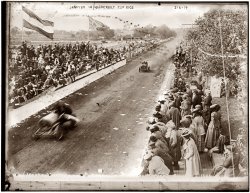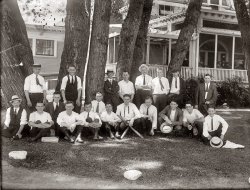
MAY CONTAIN NUTS

Search Shorpy
SHORPY ART

Framed or unframed, desk size to sofa size, printed by us in Arizona and Alabama since 2007. Explore now.
Join and Share
Ad-Free Shorpy
Shorpy is funded by you. Patreon contributors get an ad-free experience.
Learn more.

Recent comments
- Baldwin 62303
- Baldwin VO-1000
- Cold
- No expense spared
- Tough Guys
- Lost in Toyland
- And without gloves
- If I were a blindfolded time traveler
- Smoke Consumer Also Cooks
- Oh that stove!
- Possibly still there?
- What?!?
- $100 Reward
- Freeze Frame
- Texas Flyer wanted
- Just a Year Too Soon
- WWII -- Replacing men with women at the railroad crossing.
- Yes, Icing
- You kids drive me nuts!
- NOT An Easy Job
- I wonder
- Just add window boxes
- Icing Platform?
- Indiana Harbor Belt abides
- Freezing haze
- Corrections (for those who care)
- C&NW at Nelson
- Fallen Flags
- A dangerous job made worse
- Water Stop
Member Photos
The Shorpy
Print Emporium
Print Emporium
Search Shorpy
Search results -- 30 results per page
- Grove Lime & Coal: 1920
- ... have a representative number of trucks in Brooklyn, N.Y.; Long Island City, and New York city. In New York territory, they have ... Posted by Dave - 08/09/2012 - 7:51am -
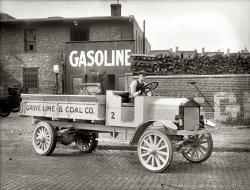
- Surf Club: 1947
- August 1, 1947. "Surf Club, Atlantic Beach, Long Island, New York. Beach scene III." Ever alert for signs of distress, the ... Posted by Dave - 03/28/2013 - 12:13pm -
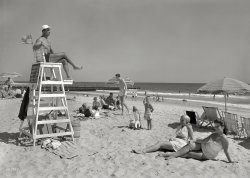
- Payday: 1905
- ... celebrate its Italian origins. The vessel's adventure off Long Island was not its last voyage. Over the next decades she sailed as ... Posted by Dave - 09/11/2013 - 9:44am -
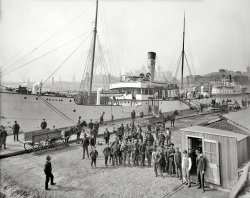
- Boats Bait Beer: 1910
- ... July 1910. "Goose Creek, houses on the water, Jamaica Bay, Long Island." 5x7 glass negative, George Grantham Bain Collection. View full ... Posted by Dave - 09/13/2011 - 12:35pm -
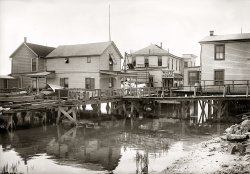
- Respect My Authoritah: 1954
- ...
Oct. 7, 1954. "Police desk, Village Hall, Garden City, Long Island, N.Y. Moore & Hutchins, client." Large-format negative by ... Posted by Dave - 03/19/2014 - 2:16pm -
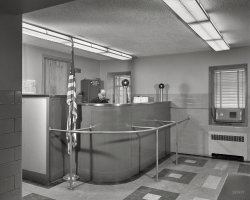
- In My Back Yard: 1929
- Long Island or Connecticut circa 1929. "Unidentified women, possibly Elizabeth ... Posted by Dave - 01/09/2015 - 4:12pm -
![In My Back Yard: 1929 Long Island or Connecticut circa 1929. "Unidentified women, possibly Elizabeth Duncan dancers." 4x5 nitrate negative by Arnold Genthe. View full size.
Again??Time to call Orkin.
It Happened to Us!Our back yard has a big lawn surrounded by a small woods, making it feel quite pastoral. Once, our church filmed some interpretive dancers doing their bit back there. So, this picture is as relevant now as it was nearly a century ago!
Isadora?Shouldn't that be Isadora Duncan?
[Not when referring to her sister Elizabeth. -tterrace]
EtherealI love this photo! Reminiscent of the calm, less complex time, before our current high tech intensity.
Why, umm, no. "Does this gauzy dress-like garment with the rubber band thingy situated awkwardly beneath my posterior make me look fat?"
I can't define "diaphanousness"But I know it when I see it.
(The Gallery, Arnold Genthe, Dance)](https://www.shorpy.com/files/images/SHORPY-7a02625a1.thumbnail.jpg)
- After the Baseball Game
- ... Conn., which is a tough and poor city on the coast of Long Island Sound. Brooklawn CC is right on the border of Bridgeport but is ... Posted by rapidrobert - 09/22/2011 - 11:37pm -
- Now Highering: 1912
- ... home, Winfield Hall, in Glen Cove on the North Shore of Long Island.
Just for comparison, The Woolworth Building started ... Posted by Dave - 10/16/2019 - 8:44pm -
![Now Highering: 1912 New York circa 1912. "Broadway, looking north from Cortlandt Street and Maiden Lane." Our second look in recent weeks at the Woolworth Building in the final stages of construction. 8x10 inch dry plate glass negative. View full size.
Mourning jewelry window signAs anyone who every watched "Antiques Roadshow" or has done any research into old jewelry knows, it used to be a common practice to mourn one's dear departed with "remembrance" jewelry to keep in mind the loved ones who are no longer with us. Some people were in mourning for years and others, like Queen Victoria, mourned her late husband Albert for the remainder of her long life. Lots of this jewelry has black stones or black metal and some of it even incorporated locks of hair of the deceased. Some of it was exquisite and very expensive and is in museums it is so valuable, and some not so much. I had never seen it advertised in other Shorpy pictures though, so this is a first for me.
"The Tubes"Pole sign, "Hudson Tunnels" - The Hudson and Manhattan Railway Tunnels - Known locally as "The Tubes"; service began between Lower Manhattan and Jersey City, July 19, 1909. Known today as the PATH System by the younger folk, but still the Tubes to me.
What, pray tell... is that statute on top of one of the buildings.
[Appropriately enough, it's atop the Walkover Building. -tterrace]
Cable railwayMany people will know of the cable cars of San Francisco, this picture shows a similar system in New York. The Broadway cable railway opened in 1893 and ran Battery Place from Whitehall Street to Broadway - Broadway to Seventh Avenue - Seventh Avenue to 59th Street.
The motive power was provided by a continuous steel cable running in a slot under the street between the rails. The central powerhouse was at Houston and Broadway.
[Those slots are for access to underground electrical conduits. The last of Manhattan's cable-powered lines had been converted to electricity by 1901. -tterrace]
street lightWhat is the smaller light (?) just behind the street light across Maiden Lane?
Conduit CleaningThe rectangular panels located between the streetcars' running rails and the centered slot rails were to allow access to the electrical conduit whenever necessary to clear the conduits accumulation of the abundant brown debris seen on the surface of the street.
PurportedlyWoolworth could see the completed building from his summer home, Winfield Hall, in Glen Cove on the North Shore of Long Island.
Just for comparison, The Woolworth Building started construction in 1910, and Winfield Hall was rebuilt (after a rather suspect fire) in 1916; the skyscraper cost an estimated $13.5M to build, while the rebuilt Winfield Hall racked up an impressive price-tag in excess of $11M -- including a $2M marble staircase.
Fire Alarm Box LightIn response to the post by Jmarksr: The smaller light beyond the streetlight marks the location of a Fire Alarm Box. This lamp will have a red glass shade. At night, one could immediately locate the nearest fire alarm box by looking for a red lamp.
In my youth, the globes in some towns & cities were red, and in others the globes were orange. I don't know why.
(Some towns also had green lamps on police call boxes.)
The early fire alarm boxes were "Telegraph" boxes which used an ultra-reliable spring-wound clockwork mechanism to tap out the code of the fire box on a dedicated telegraph line to the Fire Dept., where it was recorded as punch marks on a moving paper tape. (Later, some cities converted to an actual telephone system.)
The telegraph system was powered from lead-acid batteries at the Fire Dept. It would function even during a power failure, as the batteries could support the system for many days.
(The Gallery, DPC, NYC, Streetcars)](https://www.shorpy.com/files/images/SHORPY-4a25583a.thumbnail.jpg)
- Candlelight Parking: 1951
- ... "Patricia Murphy's Candlelight Restaurant, Manhasset, Long Island, New York. Exterior, with autos." Nonconformists will please park ... Posted by Dave - 10/14/2017 - 10:03am -
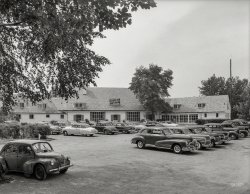
- Modern Family: 1962
- ... to be forgotten.
Winston (Wink) Butz
Formerly from Long Island, NY
Now located in Strasburg, PA
Seating by Rubbermaid The ... Posted by Dave - 04/29/2014 - 1:48pm -
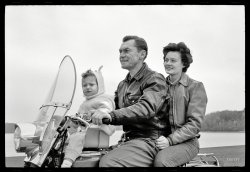
- Macy's: 1905
- ... is a news photo from 1944. The crowd there were probably Long Island Railroad Commuters. NYC's Penn Station is a few short blocks from ... Posted by Dave - 04/21/2014 - 6:24am -
![Macy's: 1905 1905. "R.H. Macy & Co., New York." The famous department store. Corner tenant: Lucio's, the jeweler whose pearls, rubies and diamonds "defy detection." 8x10 inch dry plate glass negative, Detroit Publishing Company. View full size.
A Bygone EraWhat a wonderful photo. I see several men carrying either a doctors bag or briefcase and everyone is dressed in their elegant finery, a far cry from what you would see today on any sidewalk. I often wonder what it was really like to have lived back then.
Happy Days Are Here AgainShortly after the U.S. ended Prohibition in December, 1933, R H Macy's was awarded New York State's first Liquor License. Attached is a news photo from 1944. The crowd there were probably Long Island Railroad Commuters. NYC's Penn Station is a few short blocks from Macy's.
Looking westThis view shows the eastern side of Macy's, with Broadway and Herald Square in the foreground. Most likely, the photographer was on the platform of the 34th Street station of the Sixth Avenue El, Sixth Avenue forming the opposite side of Herald Square. At the extreme right is the famous James Gordon Bennett Memorial statue, honoring the founder of the New York Herald newspaper from which the square took its name.
35th Street heads away from Broadway on the right side of the picture. Then as now, Macy's delivery and service entrances are along the 35th Street side. One thing apparent from the view of this side is that the Macy's building in 1905 was much smaller than it is today. Over the next 20 or so years it was expanded in stages to the west until it reached Seventh Avenue.
The Lucio's building on the corner of Broadway and 34th is part of Macy's lore, as when the store was in the planning stage Lucio's owner refused to sell. Whether he was trying to stop construction entirely or was just holding out for a big payoff is not certain. Whatever the case, Macy's simply built around the smaller building, and did not demolish it even after acquiring the property some years later. The building's still there today, on the ground floor housing what must be the world's best-located sunglasses shop, though it's best known for the huge Macy's advertising signs that cover the upper stories.
At lower left is a statue of copper mining baron William Earl Dodge, who became a leading philanthropist and helped organize the YMCA. It was sculpted by the famous sculptor John Quincy Adams Ward and dedicated in 1895. In the early 1940's it was moved several blocks away to Bryant Park to accommodate renovations to Herald Square.
Work CrewWhat a great photo! Truly a moment frozen for all time. I was drawn to the "manhole crew" at the lower right. Soft hats, no safety signs or extensive traffic barriers, woman crossing right over the cord, etc. A different world! Lack of auto traffic is certainly a factor. Can anyone elaborate on what the crew is doing? Is the tool powered by air or electricity?
Artificial, it seemsI've found other old ads for the company and they call them "scientific" diamonds -- and they "defy detection" is because you can't tell them from real "old mine" diamonds.
I think we'd call them now artificial - even back then, the technology was new but pretty good.
[Gem-quality synthetic diamonds, which are identical chemically (if not spectroscopically) to geologic ones, got their start in the 1970s. What Lucio's was selling is probably what we would call costume jewelry. -Dave]
Defy detection?Does that mean they can't be found, or they're so fake no one will be able to tell the difference?
(The Gallery, DPC, NYC, Stores & Markets, Streetcars)](https://www.shorpy.com/files/images/SHORPY_4a12205a.thumbnail.jpg)
- Festival of Gas: 1965
- May 6, 1965. "World's Fair, Flushing, Long Island. Robert & Frances Vargo from Verplanck, N.Y., with Madame Grace ... Posted by Dave - 11/30/2015 - 1:15pm -
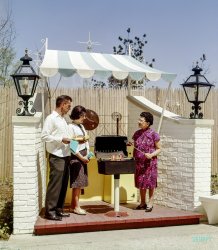
- PA Flyer: 1905
- ... built by the PRR Juniata shops for themselves and for the Long Island Railroad, but these are 4-6-0's and have sandboxes. IIRC many if ... Posted by Dave - 04/24/2014 - 12:57pm -
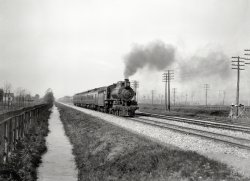
- Hell Gate: 1930s
- ... Up the East River from New York Harbor and from Long Island Sound to the east.
General Electric Right behind the Waldorf ... Posted by Dave - 09/25/2013 - 2:16pm -
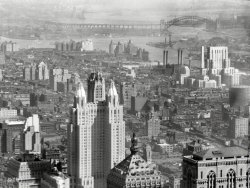
- Crow Girl: 1910
- ... came when she was 16, died after a train hit her car at a Long Island grade crossing in 1944.
You will see things Fascinating, ... Posted by Dave - 08/19/2012 - 3:18pm -
![Crow Girl: 1910 Marion Gaynor, daughter of New York Mayor William J. Gaynor, and her pet crow "Pete" circa 1910. View full size. 8x10 glass negative, George Grantham Bain Collection. Marion, an animal lover whose first of four marriages came when she was 16, died after a train hit her car at a Long Island grade crossing in 1944.
You will see thingsFascinating, just today I read that children in Imperial Rome kept crows as pets, and I found it hard to believe!
As Don Quixote told Sancho Panza: "You will see things"
[I had a pet crow when I was 17. - Dave]
CrowsThere was a crow that would come around my house years ago and eat out of our hands. We'd pet him (or her) and he'd make happy "purring" noises, and we'd give him pieces of tinfoil. They're wonderful, intelligent animals!
(The Gallery, Animals, G.G. Bain)](https://www.shorpy.com/files/images/01179u2.thumbnail.jpg)
- Meet Me in St. Louie: 1904
- ... this photo was taken, my mom and I came out here from Long Island, to see my dad, who was stationed at Scott Field, in the Army Air ... Posted by Frisco1522 - 09/19/2011 - 1:37pm -
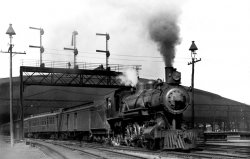
- Gray Saturday: 1951
- ... ago:
Dec. 1, 1951. "Shopping center, Great Neck, Long Island, New York. Wanamaker's." Large-format negative by ... Posted by Dave - 12/26/2013 - 2:09pm -
![Gray Saturday: 1951 As an alternative to Black Friday, we present Gray Saturday. More specifically, the first day of December 62 years ago:
Dec. 1, 1951. "Shopping center, Great Neck, Long Island, New York. Wanamaker's." Large-format negative by Gottscho-Schleisner. View full size.
Dr. FuselageThe next-to-the-last car on the right (is that a Hudson?) brought back memories of my father, who was perfectly content to forgo the shopping experience and sit in the car, listening to the radio.
[It's a Nash. -tterrace]
Beautiful CarsAll those beautiful cars, with their magnificent chrome bumpers, lined-up at the curb in front of the store.
Garden of Great NeckJust over a year old in this picture, Garden of Great Neck was by some accounts the first suburban-style shopping plaza* in the New York metropolitan area. Definitions can be a bit fuzzy so it's hard to be certain. It's still a thriving center today, though of course it's been greatly renovated over the years. Great Neck is a very upscale community, and this center benefits from a prime location right in the center of town.
Wanamaker's was gone by 1955, but other department stores occupied its space for another 20 years. Today there's a supermarket on the lower level of the space, and if I'm not mistaken a fitness center occupies the upper part.
* shopping plaza is a much better term than that modern abomination "strip mall."
Great Neck today has a large Jewish population and a large Iranian population. While that sounds like a recipe for World War III, by all accounts everyone gets along fine.
Bathtub NashThe car to the left of the woody, to elaborate upon tterrace's identification.
(The Gallery, Cars, Trucks, Buses, Gottscho-Schleisner, Stores & Markets)](https://www.shorpy.com/files/images/SHORPY_5a20791u.thumbnail.jpg)
- American Bye: 1968
- ... the train's passage on the TV in my parents' home on Long Island. Nine days later I was inducted into the Army on my way to Vietnam. ... Posted by Dave - 08/24/2013 - 2:00pm -
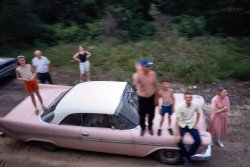
- Iced Tea Terrace: 1945
- ... October 13, 1945. "Childs Frick residence in Roslyn, Long Island, New York. Guest cottage south facade." 5x7 negative by ... Posted by Dave - 03/06/2017 - 10:12pm -
![Iced Tea Terrace: 1945 October 13, 1945. "Childs Frick residence in Roslyn, Long Island, New York. Guest cottage south facade." 5x7 negative by Gottscho-Schleisner. View full size.
LovelyI want to hang out here.
[There's a quality that draws me as well. I can't quite put a name to it. -tterrace]
Clayton 2This estate was named Clayton, after the home he grew up in - the Pittsburgh estate of his father, Henry Clay Frick. Childs felt he didn't inherit what he should have; I'd say he did alright.
It's Seen Better DaysWhile the historical view looks like the kind of place where Kathryn Katharine Hepburn might have been seen planning a cinematic weekend, the modern view of what's best known as the Jerusha Dewey House shows that time hasn't been so kind.
[This photo dates from 2008, three years before the 2011 restoration seen in the later comment. -tterrace]
And better days are here againNow owned by the Nassau County Museum of Art, and all fixed up.
Re: LovelyCompared with the blunt angles of the two photos provided below, the half-profile of the guest cottage is a far more flattering and intriguing view. Framed by the tree above and descending flagstone pathway drawing the eye in, not to mention the delightful volumes and good bones of the house itself, the scene is utterly charming. Gottscho uses his mastery of lighting to great effect, imparting an almost cinematic quality to the scene, which heightens the fantasy allure and attracts us even more. I expect to see a young Judy Garland run out laughing at any moment, or maybe a smart-talking Katharine Hepburn in trousers.
(The Gallery, Gottscho-Schleisner)](https://www.shorpy.com/files/images/SHORPY-5a12272u.thumbnail.jpg)
- Oyster Bay: 1908
- ... at Sagamore Hill, the president's estate near Oyster Bay, Long Island. View full size. 5x7 glass negative, George Grantham Bain ... Posted by Dave - 12/10/2007 - 6:17pm -
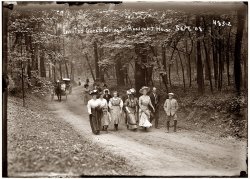
- See You Next Fall
- ... Art Project silkscreen poster promoting Sea Cliff, Long Island. View full size. Now a fine-art print.
(The Gallery, Art & ... Posted by Dave - 12/09/2007 - 9:52pm -
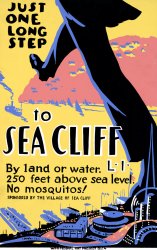
- More Marblehead: 1906
- ... pick up the stuff dropped by slobs in front of my home on Long Island.
I'm worried about the gap in the clothes line however. Great ... Posted by Dave - 10/22/2012 - 12:22pm -
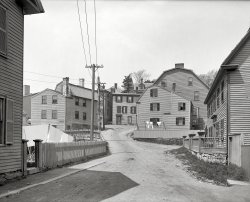
- Battling Mantell: 1911
- ... 25, 1890 and died on November 2, 1959. He was buried in Long Island National Cemetery, Section V, Site 6732. He appears to never have ... Posted by Dave - 08/10/2012 - 3:45pm -
![Battling Mantell: 1911 The boxer Battling Mantell in November 1911. View full size. George Grantham Bain Collection. So who can tell us about old Bat? He served in World War I.
Battling Mantell's record -- 20 fights, just one victoryHe went on to become a referee.
http://www.boxrec.com/boxer_display.php?boxer_id=185088
[I think that's an incomplete record. - Dave]
What a JockAs an athletic supporter, I wonder where's his punching bag and medicine balls.
Benjamin Baer MantellThis appears to be Benjamin Baer Mantell.
Searching through Veterans Records on Ancestry.com I found Benjamin B. Mantell at the Soldier's Home in Virginia in 1931 - 1932. It says that he was a Physical Instructor for his occupation, so this seemed like a good place to continue the search.
It says he was 5' 4 1/2" tall with brown hair and eyes and was of the Hebrew faith. He enlisted on February 14, 1914 as a Private in Company C, 15th U.S. Cavalry and was discharged on June 4, 1920.
The cause of his admission to the home says, "Mental Questionable," and what looks like, "Cebro Spinal Cervrio" (probably cerebro-spinal in current language).
Searching further records I found he was born on November 25, 1890 and died on November 2, 1959. He was buried in Long Island National Cemetery, Section V, Site 6732. He appears to never have been married.
The 1930 U.S. Federal Census shows him at 246 Keap Street, Brooklyn, NY. It lists his profession as a Pugalist, Professional, and it also shows him as a WWI Veteran.
His father was Russian and his mother Austrian, but I have not been able to find their names. His grandmother was Rebeca (Bessie) Mantell an aunt was Fannie Loefkowitz.
The boxing site below lists three Battling Mantells. It seems very unlikely that you would have three professional boxers all using the same name. Looking at the fight dates, only two of the fights are on consecutive dates so conceivably this is all one person fighting in two primary locations (usually New York and Pennsylvania). All of the fights are before he enlisted with the exception of three: one on the day he enlisted; one on May 11, 1914; and one on May 27, 1915. He could have been in the fight on May 11, 1914 prior to leaving for his enlistment, and he could have been in the fight on May 27, 1915 while on leave.
The Stars and Stripes, France, for Friday, May 10, 1918 states, "Before the main bout, Battling Mantell, New York lightweight now a cavalryman, was introduced." Note it does not say that he fought anyone that night.
With a middle name like "Baer" I'm surprised he didn't have a different fighting name.
(The Gallery, G.G. Bain)](https://www.shorpy.com/files/images/09914u.thumbnail.jpg)
- Guest House & Garden: 1945
- ... Oct. 13, 1945. "Childs Frick residence, 'Clayton,' Roslyn, Long Island. South facade." Large-format acetate negative by ... Posted by Dave - 08/06/2014 - 3:48pm -
![Guest House & Garden: 1945 Oct. 13, 1945. "Childs Frick residence, 'Clayton,' Roslyn, Long Island. South facade." Large-format acetate negative by Gottscho-Schleisner. View full size.
Built by poet William Cullen BryantDesigned by artist Frederick S. Copley, the house was built in 1860 by William Cullen Bryant as a guest cottage. Poet Jerusha Dewey, a close friend of Bryant's, occupied it for several years. The larger Frick mansion now houses the Nassau County Museum of Art. Bryant's guest cottage is still there.
My backyardThe museum grounds served as such when I lived in a nearby apartment for many years (free access to the grounds on weekdays); at the time, the cottage was in a sad state of repairs, completely overgrown & near collapse.
It was gratifying to see it restored when funds became available; the sleeping porch was not restored as it was a later addition to the original construction. What saved it was probably the sturdiness of the first floor brick nog walls, a construction technique in which bricks are used to fill the vacancies in a wooden frame.
Ch...ch...ch...changesI'm happy that the house still exists but it sure doesn't look as "cozy" as it did. Looks downright industrial. If I'm not mistaken, the room in the original picture that is upstairs and to the right was a sleeping porch. They were certainly necessary in the days before air conditioning. Wonderful nights with breezes blowing and crickets making their contribution. Scarce as hen's teeth these days, seems all renovators feel the need to remove them.
[That's a glassed-in sunroom full of potted plants. - Dave]
Frederick S. CopleyWas he related to artist John Singleton Copley?
(The Gallery, Gottscho-Schleisner)](https://www.shorpy.com/files/images/SHORPY-5a12273u.thumbnail.jpg)
- Semaphore: 1920
- ... not sure).
Some things never change. I work for the Long Island RR, and it seems that very little changes in train yards. The ... Posted by Dave - 09/11/2011 - 1:10pm -
![Semaphore: 1920 Washington, D.C., circa 1920s. "Union Station signals and tracks." National Photo Company Collection glass negative, Library of Congress. View full size.
Riding on the MetroI ride by here daily on the Metro. I believe this is facing west [it's north-northeast - Dave]. The landmark that stands out is the switching house, which is still there, and in the photo is at the lower middle slightly to the left. If I have my orientation, right, the Metro Red Line goes by on the left, where you can kind of see a train in the photo. This would be facing with your back to Union Station.
When I see the switching house, it looks like it's 100 years old. It's green-copper stained with some gray. Most of those tracks are still there, and there's now also some old electric train wires hanging overhead which may date back to the 50s (I am not sure).
Some things never change.I work for the Long Island RR, and it seems that very little changes in train yards. The equiptment changes with the times but not much else. It's definitely a bit of a throwback occupation.
K TowerThis is a fantastic photo of the place I have worked since 1990 - K Tower, Washington Terminal. It controls all of the former Washington Terminal signaled trackage. Semaphore signals were replaced in the 1950's with color position signals.
Richard Hafer
K Tower Train Director
(The Gallery, D.C., Natl Photo, Railroads)](https://www.shorpy.com/files/images/31702u_0.thumbnail.jpg)
- A Diamond for Lil: 1959
- March 3, 1959. "Long Island Lighting Co. trucks and men." A Diamond T truck bearing the ... Posted by Dave - 03/10/2014 - 7:28am -
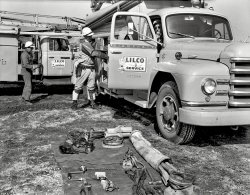
- Doubleday & Co.: 1948
- ... an airplane, so that he could fly from Roosevelt Field on Long Island to Hanover (a 45-minute trip), to make frequent inspection trips to ... Posted by Dave - 12/12/2016 - 8:45pm -
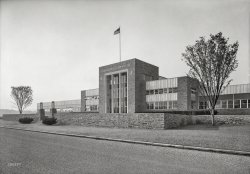
- A gentle Shepherd tending his flock
- ... abilities too. I believe this was taken in Hempstead on Long Island. Their kennels were located in the area of farmland which became ... Posted by A.T.Rollin - 09/20/2011 - 12:47pm -
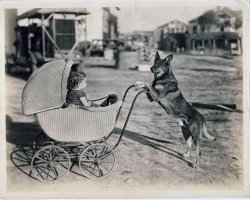
- Miss Fudge: 1921
- ... My big boy, Max, was buried in the Bide-a-Wee cemetery on Long Island, NY. The same place Nixon's 'Checkers' is buried. I would rather ... Posted by Dave - 02/22/2008 - 5:27pm -
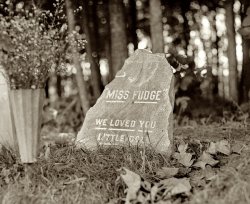
- Vanderbilt Cup: 1908
- ... photo is from the 1906 Vanderbilt Cup held on October 6 on Long Island. Jenatzy drove the Mercedes 120hp #3 and in the back is Arthur ... Posted by Dave - 05/09/2009 - 10:52pm -
